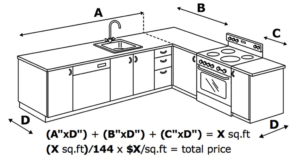Renovations Require Demolition Down to the Bare Studs

The answer is that demolition that includes removing wallboard, plaster, and other wall surfaces allows access to areas that can be upgraded prior to and during the kitchen renovation. It also facilitates design options such as pass-through windows, breakfast bars, and other popular additions.
Interior Access
Contractors usually want to access areas behind walls because that’s where things like electrical lines, plumbing, and ventilation are located. Upgrading or expanding electrical, plumbing, and ventilation brings outdated kitchens into the present and also prepares them for the future.
For example, new and improved lighting may require electrical lines where they didn’t exist before. If demolition to the bare studs wasn’t performed first, electrical lines would have to be installed on the outside of the walls rather than on the inside. While the walls are down, you can rewire the kitchen, putting outlets, power lines, and lighting in new places.
Similarly, plumbing upgrades like new dishwashers or sinks with higher capacity typically require access to the plumbing behind walls, under sinks, and other areas that only can be exposed through bare stud demolition.
Design Features
As every architect and contractor knows, before you can build you first have to destroy. Demolition down to the bare studs gets rid of all the old design features of your kitchen so that you can replace them with new, upgraded, and more desirable elements — like new walls where they didn’t exist before, removal or relocation of obstacles or inefficiencies, and reconfiguration of appliances, cabinets, and countertops.
Tearing out your old kitchen is just the first necessary step of improving the design, functionality, and style of your new kitchen. Think of it as preparing a clean canvas upon which you can paint a portrait of the kitchen of your dreams.









